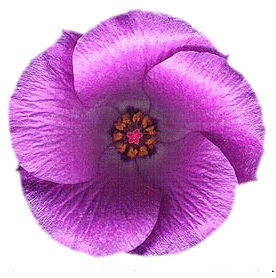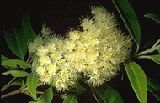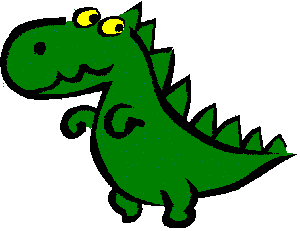|
[Front Page] [Features] [Departments] [SGAP Home Page] [Subscribe]

Net Watch...choice selections on the 'net

"Net Watch" is about finding sites that might be useful to those interested in Australian native plants but it's not restricted to horticultural or botanical sites. A few "general interest" sites are included and a couple of others are "thrown in" for no other reason than that they redefine the term "bizarre". If you know of a site that fits into these general categories, please let me know.
Brian Walters

The Living World
  Hibiscus from Down Under Hibiscus from Down Under
Hibiscus is justifiably one of the most popular plants in cultivation. The many cultivars of this genus are seen in warm climate gardens in many parts of the world.
 
But how many people realise that Australia has a number of Hibiscus and Hibiscus-related plants of its own? Not many I suspect because they are rarely seen in gardens.
Colleen and Geoff Keena and Hibiscus World would like to raise the profile of Australia's native Hibiscus and are releasing a range of species and cultivars which will (hopefully) see these attractive plants grown more widely. Colleen and Geoff's web site, Australian Hibiscus and Hibiscus-like Plants, is an excellent introduction to the Australian Hibiscus family as it contains clear and informative details on and photographs of members of the genus and the related genera Gossypium and Alyogyne.
Spend a little time here and you'll want to grow a few of these plants in your own garden.
The illustration is of a manipulated hybrid between two forms of A.huegelii.

  Lemon Myrtle Lemon Myrtle
Backhousia citriodora (lemon myrtle) is one of Australia's native plants with potential for commercial exploitation. It's intensely lemon-scented foliage is due to a high concentration of essential oil (citral). Anyone who has crushed the leaves of this plant and experienced the aroma will testify that the smell is "more lemon than lemon"!
 |
The massed display of white flowers of Backhousia citriodora is an additional reason for cultivation of this species.
Select the thumbnail image or highlighted name for a higher resolution image (37k).
|
This site, compiled by Nicholas Reese, is a compendium of virtually all that there is to know about lemon myrtle. Here you will find.......
- Background information - historical oil extraction, culinary uses.
- Distribution
- Oil yields and features
- World market for oil
- Cultivation notes

  Weedbusters Weedbusters

National Weedbuster Week was launched in 1997 and was successfully organised for a second time in 1998. The aim of Weedbuster Week is, naturally enough, to raise awareness of the impact of weeds on the Australian environment and to encourage activities designed to tackle the weed problem at the local community level.
1998 Weedbuster Week will be held from 10 to 17 October with the theme of "Weed prevention is the intention". Activities will vary from State to State and the web site lists Regional coordinators who can advise on activities in specific areas.
The site features "Woody Weed"......."a rogue who spreads himself around the countryside (like any successful weed!) scaring children and harassing wildlife. Dressed in bright purple and green, he makes as intimidating sight to any unsuspecting passer-by."
To be kept informed about Weedbuster Week activities in 1998 and in future years you can join the email listserver to get regular news.

  Plants for a Future Plants for a Future
This is a very impressive project...UK based but with a good representation of Australian species, very detailed and apparently accurate as well!

Plants for a Future is a resource centre for rare and unusual plants, particularly those which have edible, medicinal or other uses. The site includes a searchable database of over 7000 species and can be searched in a number of ways:
- Search by name, common name or family.
- Search for an edible, medicinal or other use.
- Search for plants native to a particular area.
- Search for plants which grow in a particular habitat.
- Search every field for a particular word.
As a test I searched for species native to New South Wales and the database produced 251 "hits". Certainly more than I expected! The information for each species is quite detailed and includes:
- General Description - common name, family, synonyms, distribution, habitat, habit, flower type, pollinators.
- Cultivation Guidelines - soils, aspect, sun or shade, frost tolerance.
- Medicinal and Other Uses
- Propagation Information
- Extensive list of references
In short....a very useful resource.
No Plants...But Worth Checking!
  A Cook's Tour A Cook's Tour
 
James Cook made three voyages of discovery and was killed in the Hawaiian Islands......
If you think that's all there is to know about JC...think again. The Captain Cook Study Unit is not named that without good reason!
Here is a veritable cavalcade of Cookery - anything with the remotest connection to Cook and which is available on the web is linked here! As an example.....I became aware of the site when the web manager contacted me asking permission to link to the Society's page on Callistemon "Captain Cook"!
I'm not even going to try to list the range of Cook-related topics covered. One that did catch my eye, however, was the British Natural History Museum's "Virtual Endeavour" where you can examine the below deck areas of Cook's ship "Endeavour" in 3D (but you need the Quicktime plug-in and it's not an insignificant download).

  Dinnertime at Cuddie Springs Dinnertime at Cuddie Springs
How archaeologists piece together fragments of fossils and bone to unlock the history of life on this planet is something that I find enormously fascinating. I'm sure it's not as glamorous as it sounds....no Indiana Jones adventures, that's for certain.
|
One of the mysteries that science has been trying to establish is whether early Australians and Australian megafauna co-existed. There have been numerous theories some even suggesting that the extinction of the megafauna was due to over-exploitation by humans. Scientists working at Cuddie Springs claim to have pieced together evidence to support this latter view.....
"The Cuddie Springs site in south eastern Australia provides the first evidence of an unequivocal association of megafauna with humans for this continent.........Investigations reveal a stratified deposit of human occupation and fossil megafauna, suggesting a temporal overlap and an active association of megafauna with people in the lead up to the last Glacial Maximum........"
|

|
The authors claim to have found evidence of butchering for food including chop marks on bones and blood and hair residues.
Very much "food for thought"....if you'll pardon the pun!
Over the Top!
  Mooooooo...... Mooooooo......
If you can remember computing pre-Windows, you might have come across the now almost-forgotten art form of "ASCII-ART". For the uninitiated, ASCII art is pictures made up simply of the ASCII character set (ie. letters, numerals and miscellaneous other characters designed to make computers do as they are told - a fruitless exercise, of course, but that's another story).
Anyway, this art form is not quite defunct. Here we have a site devoted entirely to ASCII cows - no, I don't know why......sometimes it's safer not to ask! If nothing else it shows that you can do an awful lot with just a few squiggles and dashes and a lot of time on your hands.
A modest example or two (but there's lots more where they came from......)
We eagerly await ASCII cats, ASCII dogs and ASCII Elvises. I'm sure there's even an ASCII-Bill Clinton site somewhere but I'm not sure I'm old enough.......
 
[Front Page] [Features] [Departments] [SGAP Home Page] [Subscribe]
Australian Plants online - September 1999
The Society for Growing Australian Plants
|